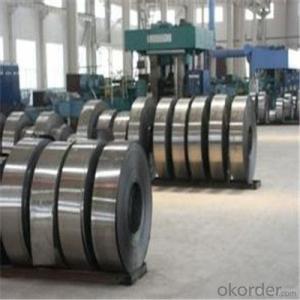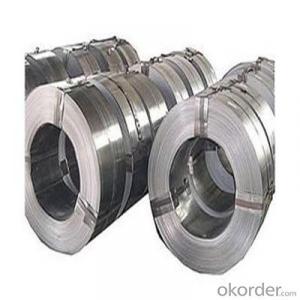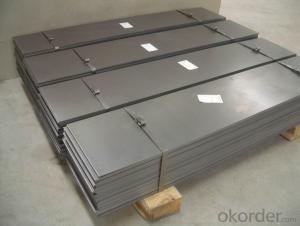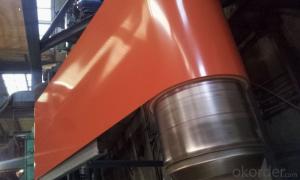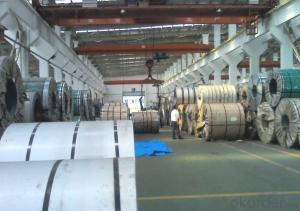Hot and Cold Rolled Steel Strip Coils with High Quality
- Loading Port:
- Shanghai
- Payment Terms:
- TT OR LC
- Min Order Qty:
- 33 m.t.
- Supply Capability:
- 122222 m.t./month
OKorder Service Pledge
OKorder Financial Service
You Might Also Like
Item specifice
Description of Steel Strip Coils:
Steel strips is one of our main products that is widely used in making band saw blade & other blades to cut paper, weed, etc.
Festures of Steel Strip Coils:
1. Each coil is closely covered by oil paper or plastic film.
2. Outside it is firmly packed with sack cloth or compound paper.
3. Steel strap or PP strap to pack the outside to ensure safety.
Specifications of Steel Strip Coils:
1:Chemical industry equipment, Industrial tanks
2:Medical Instruments,Tableware, Kitchen utensil, kitchen ware
3:Architectural purpose, Milk & Food processing facilities
Images of Steel Strip Coils:
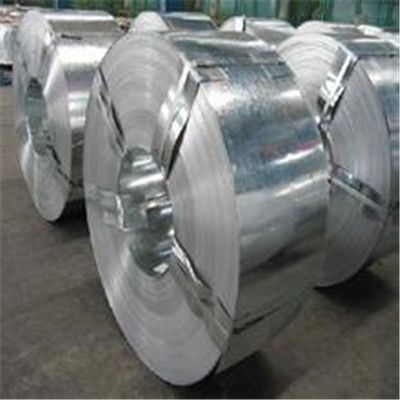
FAQ
1.What's your MOQ?
25MT, it is for one container.
2.Do you have QC teams?
Yeah, sure, our QC team is very important, they will keep the quality control for our products.
3. What's your normal delivery time?
Our delivery time about 10-20days for standard sizes, if you have other requirements like hardness and width ,it is about 20-40days.
- Q:How are steel strips used in the production of electrical components?
- Due to their exceptional properties and versatility, steel strips are commonly employed in the manufacturing of electrical components. These strips, typically crafted from high-quality steel alloys, possess qualities such as strength, durability, and resistance to corrosion. One of the main applications of steel strips in electrical component production is the creation of transformer cores. As essential components in electrical power systems, transformers facilitate the transfer of electrical energy between varying voltage levels. Laminated cores, made using steel strips, are crucial in minimizing energy losses and enhancing overall transformer efficiency. Through precise cutting, stacking, and insulation, these strips form a low-reluctance pathway for magnetic flux. Furthermore, steel strips also find utility in the assembly of electrical motors and generators. To reduce energy losses caused by eddy currents, these components require laminations composed of steel strips. By utilizing laminated cores, the generation and control of the magnetic field are efficiently accomplished, resulting in improved performance and energy efficiency. Additionally, steel strips are utilized in the production of electrical connectors, terminals, and contacts. These components necessitate high conductivity and exceptional mechanical strength to ensure reliable electrical connections. Steel strips can be shaped or formed into a variety of configurations for the creation of these components, guaranteeing secure and long-lasting electrical connections. In conclusion, steel strips are of utmost importance in the manufacture of electrical components due to their contribution of strength, durability, and excellent magnetic properties. Whether employed in transformer cores, motor laminations, or electrical connectors, these versatile materials play a vital role in enhancing the efficiency and reliability of electrical systems.
- Q:How are steel strips used in the production of automotive springs?
- Automotive springs rely on the high strength and durability of steel strips. These strips are typically made of high carbon steel, which provides the rigidity and resilience needed. To begin the manufacturing process, the steel strips are cut into desired lengths and widths. They are then heated and quenched to enhance their strength and hardness. Quenching rapidly cools the heated strips, creating a hardened surface while maintaining material ductility. The strips are then shaped into the desired spring form using methods like hot coiling or cold coiling. Hot coiling involves heating and winding the strips around a mandrel, while cold coiling shapes the strips at room temperature. The method chosen depends on specific spring requirements. After forming, the springs undergo a tempering process to relieve internal stresses and improve flexibility. This process involves reheating the springs at a lower temperature than the original quenching process, followed by slow cooling. Tempering enhances the springs' ability to withstand repeated loads and prevents brittleness-related failure. To prevent corrosion and increase lifespan, the springs are typically coated with a protective layer such as zinc or powder coating. This coating also provides an aesthetically pleasing finish. In conclusion, steel strips are critical in automotive spring production as they offer the necessary strength, resilience, and flexibility to withstand the demanding conditions associated with vehicle suspension systems.
- Q:How are steel strips used in the electrical industry?
- Steel strips are used in various ways in the electrical industry. One common application is in the manufacturing of electrical transformers. Steel strips are used to construct the laminated cores of transformers. These cores are made up of multiple layers of thin steel strips that are tightly wound together. The use of steel strips in transformer cores helps to reduce energy losses by minimizing eddy currents. Additionally, the steel strips provide mechanical support and stability to the transformer. Steel strips are also used in the production of electrical cables. They are used as armor or shielding around the cables to provide protection against external factors such as moisture, mechanical damage, and electromagnetic interference. The steel strips used in cables are typically corrugated to increase their flexibility and allow for easier installation. Furthermore, steel strips are utilized in the manufacturing of electrical enclosures and cabinets. These enclosures house electrical components such as circuit breakers, switches, and control panels. Steel strips are used to construct the frames and supports of these enclosures, providing strength and durability. In summary, steel strips play a crucial role in the electrical industry. They are used in transformer cores to reduce energy losses, in cables for protection and shielding, and in electrical enclosures for structural support. Their strength, durability, and conductivity make them an ideal material for various applications in the electrical field.
- Q:How are steel strips measured and classified?
- Steel strips are typically measured and classified based on their dimensions and properties. The measurements include thickness, width, and length, which are usually specified in millimeters. Classification is based on factors such as the steel grade, surface finish, and specific applications. The classification system helps to ensure that steel strips are accurately identified and used in the appropriate industries.
- Q:What's the meaning of "double light" in strip cold rolling?
- Double light: This is generally cold rolled roll of the statement, cold-rolled grades SPCC, SPCC is generally a general term, including SPCC-SB, SPCC-SDSPCC-SD is a single light, it is now generally rough surface is the material directly labeled SPCC, remove the suffixSPCC-SB is double light, the surface is mirror surface, also called bright surface
- Q:Can steel strips be customized?
- Yes, steel strips can be customized to meet specific requirements such as size, shape, thickness, and finish. Customization can be done through processes like cutting, slitting, shearing, and coating, allowing the steel strips to be tailored to various applications and industries.
- Q:Can steel strips be used in the production of surgical instruments?
- Yes, steel strips can be used in the production of surgical instruments. Steel is a commonly used material in the manufacturing of surgical instruments due to its durability, corrosion resistance, and ability to be sterilized. Steel strips can be shaped and formed into various instruments such as forceps, scalpels, scissors, and retractors, ensuring precision and reliability in surgical procedures.
- Q:How are steel strips processed for bonding?
- Steel strips are processed for bonding through a series of steps that involve surface preparation, adhesive application, and curing. The first step in the process is usually cleaning the steel strips to remove any dirt, oil, or other contaminants that may be present on the surface. This can be done through methods such as solvent cleaning, degreasing, or sandblasting. Once the surface is clean, it is then typically treated to enhance its bonding properties. This can involve roughening the surface through processes like sanding or etching, which create a rough texture that promotes adhesion. Alternatively, a surface treatment such as plasma or chemical treatment may be applied to modify the surface chemistry and improve bonding. After the surface preparation, an adhesive is applied to the steel strips. The adhesive chosen will depend on the specific requirements of the bonding application, such as the type of steel being used, the desired bond strength, and the environmental conditions the bond will be exposed to. The adhesive can be applied using various methods such as spraying, brushing, or roller coating. Once the adhesive is applied, the steel strips are brought together and pressure is applied to ensure proper contact and bonding. This can be done through techniques like clamping, using rollers, or applying mechanical pressure. Some bonding processes may also involve heating the adhesive to activate its curing properties. Finally, the adhesive is allowed to cure, which is the process of the adhesive hardening and reaching its maximum strength. The curing time will depend on the type of adhesive used and can range from minutes to hours or even days. During this time, it is crucial to ensure that the steel strips remain in the correct position and under the required conditions (e.g. temperature, humidity) for optimal bonding. In summary, steel strips are processed for bonding by cleaning and treating the surface, applying an adhesive, bringing the strips together under pressure, and allowing the adhesive to cure. This process ensures a strong and durable bond between the steel strips, suitable for various applications in industries such as construction, automotive, and manufacturing.
- Q:How are steel strips tested for oil or grease residues?
- Steel strips are typically tested for oil or grease residues through a process called the solvent extraction method. In this method, the steel strips are soaked in a solvent that dissolves and removes any oil or grease present on the surface. The solvent is then collected and analyzed for the presence of oil or grease residues using various techniques such as gravimetric analysis or infrared spectroscopy.
- Q:How are steel strips used in the manufacturing of cutlery?
- Steel strips are widely used in the manufacturing of cutlery due to their strength, durability, and flexibility. These strips are typically made from high-quality stainless steel, which provides excellent resistance to corrosion, staining, and wear. In the manufacturing process, steel strips are first cut to the desired length and width. The strips are then heated and molded into the desired shape, such as the blade of a knife or the tines of a fork. The heating process helps to increase the malleability of the steel, making it easier to shape and form. Once the desired shape is achieved, the steel strips are subjected to a series of processes to refine and enhance their properties. This includes quenching, tempering, and annealing, which help to improve the hardness, strength, and toughness of the steel. These processes also help to reduce any residual stresses in the metal, ensuring that the cutlery is less prone to breakage or deformation. After the strips have been shaped and treated, they are often polished to give them a smooth and shiny surface finish. This not only enhances the aesthetic appeal of the cutlery but also helps to improve its corrosion resistance and ease of cleaning. Finally, the steel strips are attached to handles or other components to complete the assembly of the cutlery. This can be done through various methods such as welding, riveting, or even using adhesives, depending on the design and requirements of the cutlery. Overall, steel strips play a crucial role in the manufacturing of cutlery by providing the necessary strength, durability, and flexibility required for everyday use. Whether it's a knife, fork, or spoon, the use of high-quality steel strips ensures that the cutlery is not only functional but also long-lasting and aesthetically pleasing.
1. Manufacturer Overview |
|
|---|---|
| Location | |
| Year Established | |
| Annual Output Value | |
| Main Markets | |
| Company Certifications | |
2. Manufacturer Certificates |
|
|---|---|
| a) Certification Name | |
| Range | |
| Reference | |
| Validity Period | |
3. Manufacturer Capability |
|
|---|---|
| a)Trade Capacity | |
| Nearest Port | |
| Export Percentage | |
| No.of Employees in Trade Department | |
| Language Spoken: | |
| b)Factory Information | |
| Factory Size: | |
| No. of Production Lines | |
| Contract Manufacturing | |
| Product Price Range | |
Send your message to us
Hot and Cold Rolled Steel Strip Coils with High Quality
- Loading Port:
- Shanghai
- Payment Terms:
- TT OR LC
- Min Order Qty:
- 33 m.t.
- Supply Capability:
- 122222 m.t./month
OKorder Service Pledge
OKorder Financial Service
Similar products
New products
Hot products
Related keywords
